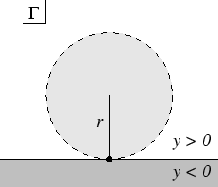Moore plane
In mathematics, the Moore plane, also sometimes called Niemytzki plane (or Nemytskii plane, Nemytskii's tangent disk topology), is a topological space. It is a completely regular Hausdorff space (also called Tychonoff space) which is not normal. It is named after Robert Lee Moore and Viktor Vladimirovich Nemytskii.
Definition

If is the (closed) upper half-plane , then a topology may be defined on by taking a local basis as follows:
- Elements of the local basis at points with are the open discs in the plane which are small enough to lie within . Thus the subspace topology inherited by is the same as the subspace topology inherited from the standard topology of the Euclidean plane.
- Elements of the local basis at points are sets where A is an open disc in the upper half-plane which is tangent to the x axis at p.
That is, the local basis is given by
Properties
- The Moore plane is separable, that is, it has a countable dense subset.
- The Moore plane is a completely regular Hausdorff space (i.e. Tychonoff space), which is not normal.
- The subspace of has, as its subspace topology, the discrete topology. Thus, the Moore plane shows that a subspace of a separable space need not be separable.
- The Moore plane is first countable, but not second countable or Lindelöf.
- The Moore plane is not locally compact.
- The Moore plane is countably metacompact but not metacompact.
Proof that the Moore plane is not normal
The fact that this space M is not normal can be established by the following counting argument (which is very similar to the argument that the Sorgenfrey plane is not normal):
- On the one hand, the countable set of points with rational coordinates is dense in M; hence every continuous function is determined by its restriction to , so there can be at most many continuous real-valued functions on M.
- On the other hand, the real line is a closed discrete subspace of M with many points. So there are many continuous functions from L to . Not all these functions can be extended to continuous functions on M.
- Hence M is not normal, because by the Tietze extension theorem all continuous functions defined on a closed subspace of a normal space can be extended to a continuous function on the whole space.
In fact, if X is a separable topological space having an uncountable closed discrete subspace, X cannot be normal.
See also
References
- Stephen Willard. General Topology, (1970) Addison-Wesley ISBN 0-201-08707-3.
- Steen, Lynn Arthur; Seebach, J. Arthur Jr. (1995) [1978], Counterexamples in Topology (Dover reprint of 1978 ed.), Berlin, New York: Springer-Verlag, ISBN 978-0-486-68735-3, MR 507446 (Example 82)
- "Niemytzki plane". PlanetMath.